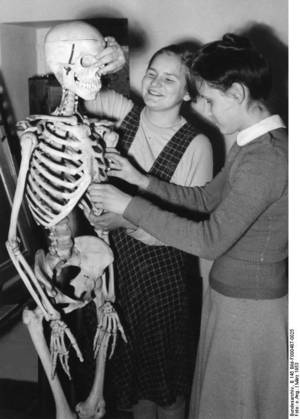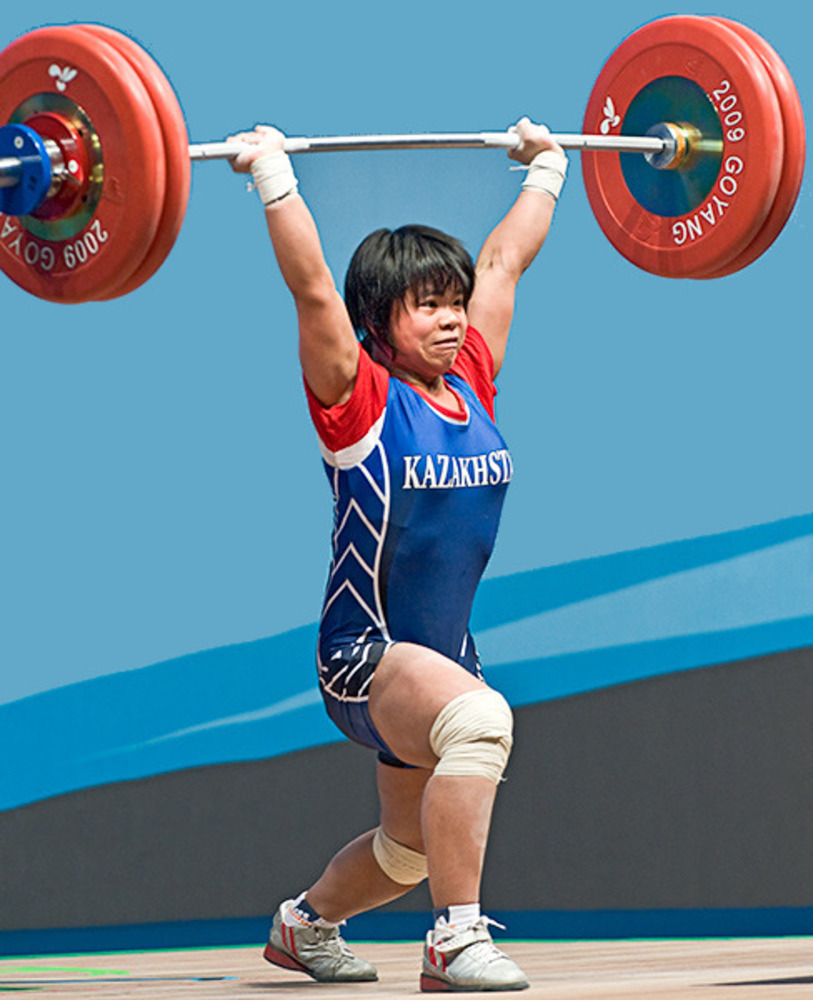Strengthening your Skeleton
Interview with
Kat - There are 206 bones in the average adult human although Dr. Chris is clearly lacking in his funny bone and has one less! But how do our bones grow and develop and what controls how strong they become? We're joined today by Professor Tim Skerry and he's from the Mellanby Centre for Bone Research at the University of Sheffield where he's looking at the impacts of exercise on bone density and how bones respond to stress. So hi, Tim.
Tim - Hello, Kat.
Kat - Now let's start by finding out what bones are. When I think of bones, I just think of a skeleton, these hard 'twigs' that are inside us, but it's not like that. What are bones made of? How do they work?
 Tim - Well it's certainly very easy to fall into that sort of trap because you see bones in museums and think "dinosaurs", and they're just sort of lumps of concrete really, but that's not the case at all. I think you only have to think about a baby being born, and the speed with which babies grow into children and then adults, to realise the skeleton is quite an unusual material for something that's apparently sort of hard and rock-like. It's made of two main components, a very strong tough protein, rather flexible, called collagen, and a mineral which is a calcium phosphate called hydroxyapatite. These combine to make a thing called a composite material like fibreglass and carbon fibre composites which are extraordinarily strong and very light. So it's a smart material arranged in a smart way and it can grow and repair itself during life.
Tim - Well it's certainly very easy to fall into that sort of trap because you see bones in museums and think "dinosaurs", and they're just sort of lumps of concrete really, but that's not the case at all. I think you only have to think about a baby being born, and the speed with which babies grow into children and then adults, to realise the skeleton is quite an unusual material for something that's apparently sort of hard and rock-like. It's made of two main components, a very strong tough protein, rather flexible, called collagen, and a mineral which is a calcium phosphate called hydroxyapatite. These combine to make a thing called a composite material like fibreglass and carbon fibre composites which are extraordinarily strong and very light. So it's a smart material arranged in a smart way and it can grow and repair itself during life.
Kat - So the idea is that the bones are really kind of dynamic living things. They're not just sticks in our body, they're constantly growing and changing, repairing themselves.
Tim - Yes, that's right and the way you should think about this is really to start with some very simple fundamentals. If you think that when we're conceived and born, no one knows what our lives are going to be. Some of us will be weight lifters, some of us will be more sedentary people, and the sorts of activities we're going to do in our life will vary hugely. Now, if the bones we had were purely determined by some sort of genetic thing, then we'd all have to have extremely strong skeletons for the very small percentage who were going to do extreme activities. Nature doesn't really do that. It doesn't like to grow, maintain and carry around vast amounts of material that for most of us, wouldn't be used. So, very much like our muscles, our bones respond to what we do, they get strong if we use them, they get weaker if we don't use them, so that we're carrying around just enough to do the things we do with our daily life. Plus a certain amount of safety factor to cover for those occasional high impacts.
Kat - When you accidentally fall over or something like that. What sort of things can actually affect the density of your bones? How can we make our bones stronger?
Tim - Well, exercise is the most important thing that a single person can do. Everyone talks about genetics but you can't change that. You can certainly change the exercise you do and there's no question that if you exercise, certainly, while you're growing up, it's an extraordinarily potent stimulus to make a strong skeleton. And if you keep exercising through life then you'll end up having a strong skeleton and being more unlikely to get osteoporosis when you're older.
Kat - But what do we mean when you talk about exercise? I mean, exercise to me could be anything from Pilates to bench pressing, or running a marathon. What sort of exercise really builds your bones?
Tim - Well the way we can determine this is by measuring what we call strain or deformation. If you think about an eraser that you squeeze between your fingers, then if you squeeze it, it gets shorter. Our bones are exactly the same and they deform. So if I'm sitting down as I am now, my bones are longer than if I stood up. If I stood up, they'd be shorter because they were squashed down. So, the strains that we impose by our activities are the things that determine whether the exercise has an effect. And so, big loads that deform our bones a lot have potent effects on the skeleton. But also, exercises that impose those loads very quickly, so impacts, high impacts are more potent as a bone building stimulus than slow repetitive things. And we can really take this and work out what exercises are good for your skeleton. And they're the things which are doing a wide range of different things usually quite quickly, not things like marathon running, cycling or swimming. Now it does not say those aren't good for you, but they're just not particularly good for your bones, and if you measure the bone mass of people who do those activities at high levels, they're very little different from age-matched people in the population. So, fast impacts are very good and if you want a simple rule of thumb, if you do an exercise which makes your muscles bigger then you'll have big bones. If you do an exercise which makes your muscles trained for endurance, but they don't get bigger, then it generally doesn't affect your skeleton very much.
Kat - So, high impact would be something like squash or jumping up and down. Would something like weightlifting count?
 Tim - Weightlifting is good, it's a very interesting question because weightlifting is good because they're obviously high loads, but if you think about someone lifting weights, quite often, they lift the weight very slowly, but then they might drop it very fast. And in fact, there are experiments which have shown that the direction in which you applied these strains doesn't matter nearly as much as the speed with which they change. So it may well be that weightlifters who lift things slowly and drop them fast are getting more exercise for their skeleton by the dropping than by the lifting.
Tim - Weightlifting is good, it's a very interesting question because weightlifting is good because they're obviously high loads, but if you think about someone lifting weights, quite often, they lift the weight very slowly, but then they might drop it very fast. And in fact, there are experiments which have shown that the direction in which you applied these strains doesn't matter nearly as much as the speed with which they change. So it may well be that weightlifters who lift things slowly and drop them fast are getting more exercise for their skeleton by the dropping than by the lifting.
Kat - How is this actually happening? Obviously, there must be some kind of chemical signals from bone bending that's making the bones grow. How does this actually work?
Tim - Well, the bone is full of cells. If you take a cross-section of a piece of bone, the actual hard material has lots of cells all the way through it and these cells have processes which touch each other, and they communicate with each other. These cells, which are called osteocytes, are thought to be the cells which can sense the mechanical environment of the skeleton. So, when the bone bends, fluids flow through the bone and the cells are actually stretched and twisted and compressed. The combination of those two things means that the cells are able to perceive whether they're being loaded by more than they should be, or less than they should be, and therefore do something about that. If they see this sort of amount of loading that they're expecting, they'll send signals which keep the bone in the same size. If you do less, if you lie on a hospital bed or you go up into orbit in weightlessness as an astronaut, then that would be seen as low levels of signal, and that would lead to your bones being reabsorbed and taken away because you weren't using them very much. That certainly happens in astronauts, but generally from their legs, not their arms because they're pushing satellites around and doing stuff, but they're not doing very much with their legs. So they lose bone from the parts that aren't being used very much.
Kat - Now we're going to be talking later to Ken Poole who's going to talk about osteoporosis, the thinning of the bones, but you've mentioned that people who are in hospital or incapacitated in some way would lose their bone density. Are we trying to find out what these chemical signals are and is there any way of mimicking them? Maybe we could come up with some kind of drug that could make someone's bones mimic the effects of impact exercise without actually having to go to the gym?
Tim - I'm smiling at your question because that's exactly what I thought 25 years ago when I started doing my PhD and I thought after three years, I might have some of the answers. I have a very small number of them. It's certainly the key question, I think. We understand much more than we did about the signalling that goes on, but I think there are lots of things we don't know yet and one of the most interesting things, to me certainly, is that the skeleton can respond to incredibly brief periods of exercise. You certainly don't need to do it for very long and there are other things that suggests that the skeleton can actually remember for probably up to 24 or maybe 48 hours, things that have happened to it, and those exercises will potentiate the effect of subsequent exercise. So, to me, that's a very important thing because if we knew more about that, we might be able to make drugs that could either increase the length of that persistence of memory, or maybe make it more sensitive. As you say, potentiating the effect of a walk down to the shops, into what the skeleton might perceive as a vigorous trip in the gym.
Kat - Fantastic stuff! Thanks, Tim. That's Professor Tim Skerry from the University of Sheffield.









Comments
Add a comment